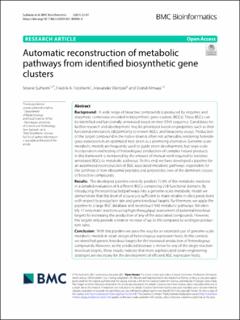| dc.contributor.author | Sulheim, Snorre | |
| dc.contributor.author | Fossheim, Fredrik A. | |
| dc.contributor.author | Wentzel, Alexander | |
| dc.contributor.author | Almaas, Eivind | |
| dc.date.accessioned | 2021-08-16T11:43:39Z | |
| dc.date.available | 2021-08-16T11:43:39Z | |
| dc.date.created | 2021-03-08T16:18:59Z | |
| dc.date.issued | 2021 | |
| dc.identifier.citation | BMC Bioinformatics. 2021, 22 . | en_US |
| dc.identifier.issn | 1471-2105 | |
| dc.identifier.uri | https://hdl.handle.net/11250/2768005 | |
| dc.description.abstract | A wide range of bioactive compounds is produced by enzymes and enzymatic complexes encoded in biosynthetic gene clusters (BGCs). These BGCs can be identified and functionally annotated based on their DNA sequence. Candidates for further research and development may be prioritized based on properties such as their functional annotation, (dis)similarity to known BGCs, and bioactivity assays. Production of the target compound in the native strain is often not achievable, rendering heterologous expression in an optimized host strain as a promising alternative. Genome-scale metabolic models are frequently used to guide strain development, but large-scale incorporation and testing of heterologous production of complex natural products in this framework is hampered by the amount of manual work required to translate annotated BGCs to metabolic pathways. To this end, we have developed a pipeline for an automated reconstruction of BGC associated metabolic pathways responsible for the synthesis of non-ribosomal peptides and polyketides, two of the dominant classes of bioactive compounds. | en_US |
| dc.language.iso | eng | en_US |
| dc.publisher | BMC/Springer Nature | en_US |
| dc.rights | Navngivelse 4.0 Internasjonal | * |
| dc.rights.uri | http://creativecommons.org/licenses/by/4.0/deed.no | * |
| dc.title | Automatic reconstruction of metabolic pathways from identified biosynthetic gene clusters | en_US |
| dc.type | Peer reviewed | en_US |
| dc.type | Journal article | en_US |
| dc.description.version | publishedVersion | en_US |
| dc.rights.holder | © The Author(s), 2021 corrected publication 2021. Open Access This article is licensed under a Creative Commons Attribution 4.0 International License, which permits use, sharing, adaptation, distribution and reproduction in any medium or format, as long as you give appropriate credit to the original author(s) and the source, provide a link to the Creative Commons licence, and indicate if changes were made. The images or other third party material in this article are included in the article’s Creative Commons licence, unless indicated otherwise in a credit line to the material. If material is not included in the article’s Creative Commons licence and your intended use is not permitted by statutory regulation or exceeds the permitted use, you will need to obtain permission directly from the copyright holder. To view a copy of this licence, visit http://creativecommons.org/licenses/by/4.0/. The Creative Commons Public Domain Dedication waiver (http://creativeco mmons.org/publicdomain/zero/1.0/) applies to the data made available in this article, unless otherwise stated in a credit line to the data. | en_US |
| dc.source.pagenumber | 15 | en_US |
| dc.source.volume | 22 | en_US |
| dc.source.journal | BMC Bioinformatics | en_US |
| dc.identifier.doi | 10.1186/s12859-021-03985-0 | |
| dc.identifier.cristin | 1896451 | |
| dc.relation.project | Norges forskningsråd: 248885 | en_US |
| cristin.ispublished | true | |
| cristin.fulltext | original | |
| cristin.qualitycode | 2 | |

